Best Magnetic Drill Press — Buyers Guide, Top Pick, and Comparison
If your standard drill simply won’t cut it — it’s time to consider a magnetic drill press. As the kings of ferrous material boring, these metal monarchs make light work of iron and steel drilling — utilizing a mighty annular cutting head instead of a traditional bit. Their electromagnetic foot bonds securely to your target material, delivering the pinnacle of stability. Internal coolant systems ensure that friction and heat are minimized, elongating the lifespan of the motor and cutting head. And, with machines capable of drilling holes two inches wide and deep — they’re suitable for a plethora of extreme DIY and trade projects.
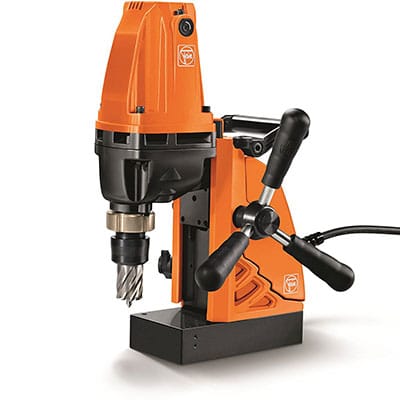
- Compact construction.
- Substantial lever handles.
- High power-to-weight ratio.
- 12.5-foot cable.
- Includes wrench and safety guard.
Magnetic Drill Press Comparison Table
| IMAGE | PRODUCT | DETAILS | ||
|---|---|---|---|---|
|
Best for DIY 
|
Best for DIY
|
JHM ShortSlugger
|
Features
|
Check Price at Amazon Review JHM ShortSlugger Review JHM ShortSlugger Review |
|
Best Variable Speed Mag Drill 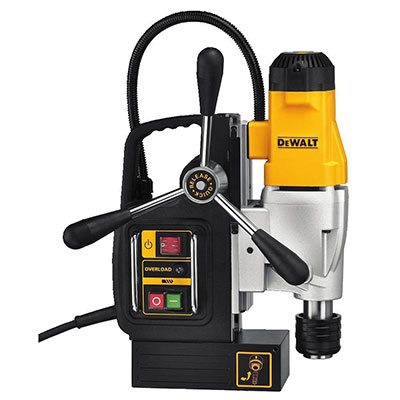
|
Best Variable Speed Mag Drill
|
DeWalt DWE1622K
|
Features
|
Check Price at Amazon DeWalt DWE1622K Review DeWalt DWE1622K Review |
|
Best for LED Accuracy 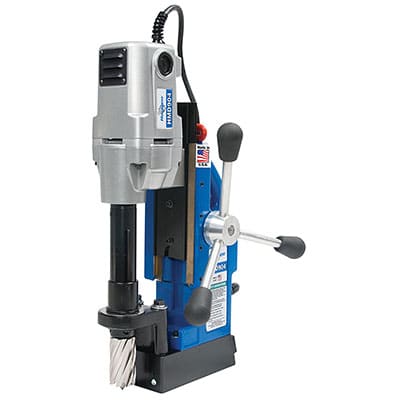
|
Best for LED Accuracy
|
Hougen HMD904
|
Features
|
Check Price at Amazon Hougen HMD904 Review Hougen HMD904 Review |
|
Best USA-Made Machine 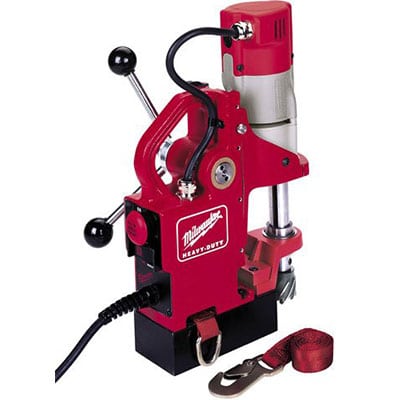
|
Best USA-Made Machine
|
Milwaukee 4270-21
|
Features
|
Check Price at Amazon Review Milwaukee 4270-21 Review Milwaukee 4270-21 Review |
|
Best Complete Kit 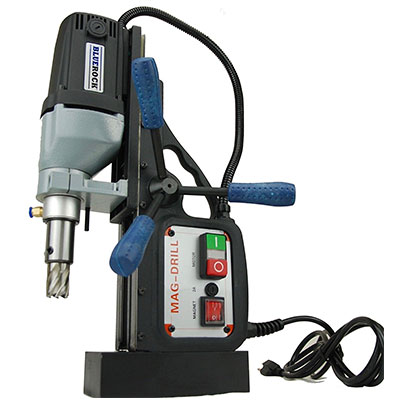
|
Best Complete Kit
|
BLUEROCK BRM-35A
|
Features
|
Check Price at Amazon BLUEROCK BRM-35A Review BLUEROCK BRM-35A Review |
|
Best for Left-Handed Use 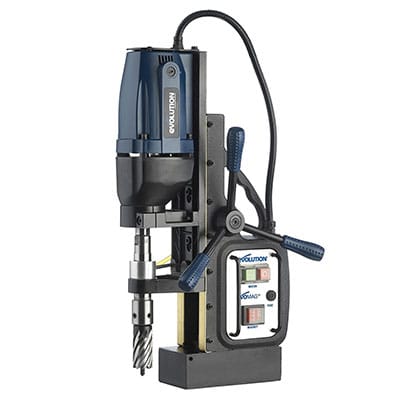
|
Best for Left-Handed Use
|
Evolution EVOMAG28
|
Features
|
Check Price at Amazon Evolution EVOMAG28 Review Evolution EVOMAG28 Review |
|
Best Low Profile 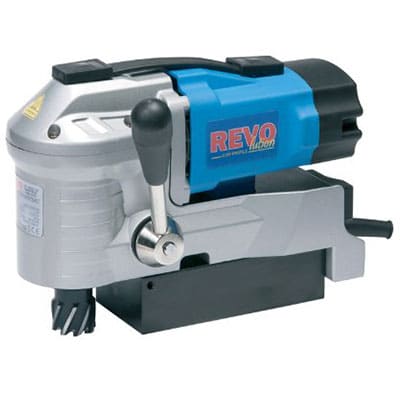
|
Best Low Profile
|
G&J Hall Tools REVO 35
|
Features
|
Check Price at Amazon G&J Hall Tools REVO 35 Review G&J Hall Tools REVO 35 Review |
|
Best Cordless Magnetic Drill Press 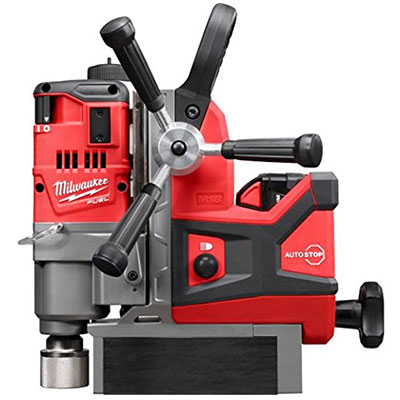
|
Best Cordless Magnetic Drill Press
|
Milwaukee 2787-22
|
Features
|
Check Price at Amazon Milwaukee 2787-22 Review Milwaukee 2787-22 Review |
Best Magnetic Drill Press Buying Guide
As the ultimate metal boring machines, magnetic drill press units are the go-to tool for hardcore, industrial-grade, high-density ferrous applications.
Featuring an integrated electromagnetic foot, they adhere tightly to their base materials — meaning they’re 100 percent metal addressing tools, so forget about using them on plastics, masonry, and timber.
Boasting a core drill head — instead of a solid bit — they’re more efficient than their standard bench and floor pillar press counterparts, allowing you to cut sizable holes that would be impossible with a typical column machine.
Furthermore, if you’re a metalworker, machinist, and engineer — these versatile metal machines allow you to cut threads (tapping), ream, and countersink in addition to the traditional drilling action.
When picking out your consummate magnetic pillar drill, consider the following:
- Drilling depth.
- Drilling diameter.
- Cutting speed.
- Size of the machine.
- Power of the electromagnet.
- Inclusion of a coolant system.
What Is a Magnetic Base Drill Press?
They’re identifiable by the following characteristics:
Magnetic Foot
The foot of both large and small magnetic drill press machines features a hardcore electromagnet that clamps onto your workpiece. This leads to impressive stability, no walking or wobbling, and permits the unit to be used vertically, horizontally, and even inverted on overhead areas. They are the only drill press format that can be used in a variety of directions.
In most circumstances, they’re utilized exclusively on iron-based mediums — although some models feature clamps to address non-ferrous materials.
Annular Cutter
Commonly known as core bits or drills, an annular cutter only cuts the exterior edge of a hole — as opposed to a standard bit that removes the interior.
This eliminates the requirement for step drilling (starting with a small bit and then gradually increasing inside to enlarge the hole), saves boring time, and provides less wear on the cutting head.
Arbor
In the most basic terms, the arbor is the chuck of mag drill presses. However, where a standard pillar chuck holds the drill bit, in magnetic machines the arbor secures an annular cutter.
Drill Column
Like their bench and floor-standing siblings, magnetic presses incorporate a drill column — sometimes called a pillar — that both supports the chuck and houses the internal electronic components and motor.
Do You Need an Electromagnetic Drill Press?
If your projects require you to bore into metals and make holes greater than 0.5 inches in diameter — you need a mag drill press.
For less hardcore metalwork, a standard corded or cordless drill will suffice with a specific metal bit. But for the extreme address of the densest of materials, it’s time to opt for a portable magnetic drill press.
Using these pro-grade tools has the advantages of:
- Low on maintenance demands.
- Two to four times faster than a standard pillar drill.
- Saves time with no pre or step drilling requirements.
- Annular cutters have a longer lifespan than metal bits.
- Fewer shards and metal detritus than a standard bit.
- Designed to be portable — as opposed to floor and bench pillar drills.
- LAbility to work on materials too large for a workshop or garage.
- Can drill vertically, horizontally, and upside down.
- Magnet provides unsurpassed stability.
- Seriously durable.
There are few downsides to a magnetic drill press — apart from being project-specific. As their stability demands a ferrous target material, they’re useless for timber or masonry applications.
Uses for a Magnetic Press Drill Machines
They’re most frequently utilized in industrial and commercial applications, for projects such as:
- Building bridges.
- Erecting prefabricated metal buildings.
- Motor engineering.
- Fabricating machines.
- Making factory boilers.
- Laying railway tracks.
- Constructing wind turbines.
- Aeronautical manufacture.
However, it’s somewhat unlikely that the standard home user or DIYer would be completing any of the above jobs. But, the smaller budget-end units can be used in non-professional circumstances for:
- Erecting cast iron fencing.
- Creating sculptures.
- Building metal garages or sheds.
- DIY tool fabrication.
- Drilling into home I-beams (also called H-beams or RSJ’s).
- Building dog kennels.
- Automotive bodywork.
- Mounting car engines.
- Making a nuclear bomb or hurricane shelter.
How to Choose the Best Magnetic Drill Press
While all units are capable of boring into dense metals, characteristics of specific models vary across the category — making them more or less suitable for your requirements.
When selecting your optimum unit, consider:
Drilling Diameter and Depth
Perhaps the primary factor when choosing the best mag drill.
Consider the thickness of the materials you’ll be addressing in the majority of your projects and how wide you need the hole to be. While most magnetic drills will penetrate to a depth of two inches, the diameter of that cut can vary significantly across models.
For example, the mighty DeWalt DWE1622K delivers a hole two inches wide and deep, while the Evolution EVOMAG28 offers a diameter of just 1.125 inches.
Magnetic Force
Generally speaking, the greater the magnetic force, the more stable the unit will be during your hardcore drilling projects.
Ideally, look for a unit machine that offers around 1500-2000 pounds of electro-adhesion or above — which will be sufficient for the majority of trade and DIY projects.
However, if you’re attacking thick metals or stubborn cast-iron — where stability could be an issue as the drill powers into the material — it might be worthwhile considering a unit with greater bonding. Furthermore, if these durable mediums are in overhead locations, then look for extreme electromagnetic attraction to prevent the unit from becoming unstuck.
For me, the consummate dense metal inverted use machine is the G&J Hall Tools REVO 35 — knocking out 3365 pounds of pure magnet adhesion.
Rotational Speed
If you’re a mag drill newbie, you may be surprised by the seemingly lethargic rotational speed of these machines.
While standard corded drills offer drilling and boring velocities in the thousands of rpm — magnetic press units typically deliver a cutting rapidity of around 400-700 rpm.
This is crucial when addressing dense metals. It keeps heat and friction to a minimum — protecting the annular cutting head, shielding the motor from overheating, and ensuring an even and true cut into your base medium.
As such, many mag drill presses feature a single speed setting — calibrated to address the majority of ferrous metal types. More advanced models — such as the REVO 35 — boast a choice of boring velocities, allowing you to tailor the output to suit your material.
Integrated Coolant Technology
Some budget mag drills lack a coolant system. Even if you’re watching your wallet — avoid these machines.
Having spindle coolant to reduce the temperature of the annular cutter is crucial — heat-shielding the head and internal components as described above. While coolant-free drills may seem attractive price-wise — it’ll turn out to be a false economy when you’re replacing your core drill cutter every few weeks.
Machine Size
While it may be tempting to purchase the mother-of-all mag drills to attack your dense ferrous materials — sometimes small and compact can be preferable.
Some projects involve working in confined and space-short areas — such as in engine bays or between I-beams — that are too small to accommodate a standard magnetic press drill.
In these circumstances, I suggest checking out one of the low-profile machines on the market, for example, the REVO 35, that allows you to access these tight locations. Furthermore, these less substantial units tend to weigh less than their more bulky cousins, making them more appealing for high-level work — especially if you’re carrying the tool up and down ladders or scaffolding.
Conclusion
Offering the ultimate in stability with their electromagnetic feature, these units make light work of ferrous materials through their annular cutting heads. When choosing your ideal unit, consider the drill depth and diameter you need, the dimensions of the machine, whether it boasts integrated cooling, and how much magnetic force it delivers.
Admittedly, being job-specific, they’re not suitable for all contractors or DIYers. Unable to address plastics, timber, or masonry, they’re redundant for many projects.
However, if you need a mighty machine to drive deep into iron-based mediums — consider purchasing a magnetic drill press.

Magnetic Press Drill FAQs
Q: What Is a Mag Drill?
A mag drill — sometimes referred to as a magnetic press drill — is a boring tool that features an electromagnetic foot to bond with the target material, naturally ferrous metal.
Q: What Is a Mag Drill Used For?
A magnetic press drill machine is used for boring into dense ferrous metals such as iron and steel. Featuring an annular cutter instead of a drill bit, combined with a brawny motor, it can penetrate thicker materials than a standard pillar drill.
Q: What Is the Best Magnetic Press Mag Drill?
In my opinion, the ultimate magnetic pillar drill on the market is the JHM ShortSlugger. It boasts a 750-watt motor, integrated coolant system, and an output of 430 rpm.
Q: What Are Mag Drill Bits Called?
The penetrating head on a magnetic drill pillar press is called an annular cutter. Unlike a traditional drill bit, it only cuts the exterior edges of the hole, and is sometimes called a core cutter.
Q: Will a Mag Drill Work on Stainless Steel?
Yes. The electromagnet of a mag pillar drill will adhere to all ferrous metals. However, it is not compatible with non-ferrous metals such as aluminum, copper, brass, and lead.
Q: What Are Two Disadvantages of a Mag Drill?
While excellent tools for addressing ferrous metal, the downsides of using a magnetic pillar press are:
- Useless on plastic and timber.
- Impractical for curved surfaces.
- Unsuitable for masonry.
- Cannot adhere to non-ferrous metals.
